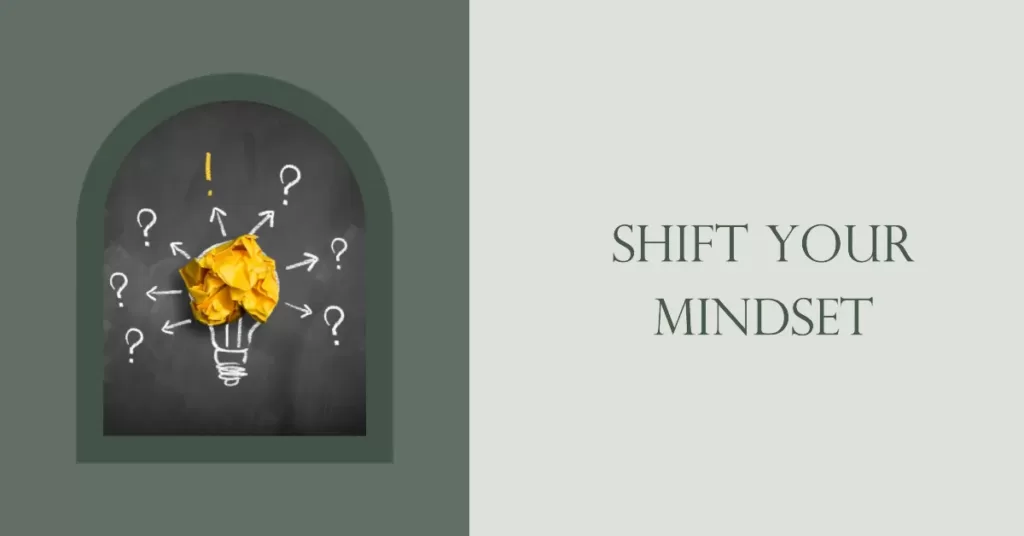Do you ever feel like your thoughts are holding you back from achieving your goals? Are you constantly stuck in a negative mindset that makes it difficult to see the possibilities in front of you? It’s time to shift your mindset and change the way you think about yourself and the world around you.
Shifting your mindset means changing the way you perceive and interpret situations. It involves becoming aware of your current thought patterns, challenging negative beliefs, and embracing a growth-oriented perspective. This process can be transformative, leading to greater self-awareness, confidence, and resilience. With the right tools and strategies, anyone can learn how to shift their mindset and unlock their full potential.
Table of Contents
Key Takeaways
- Shifting mindset involves changing perception and interpretation of situations, becoming aware of thought patterns, and challenging negative beliefs while embracing a growth-oriented perspective.
- Setting achievable objectives, developing a daily mindfulness practice, and journaling to gain insight into thoughts, feelings, and behaviors are helpful in shifting mindset.
- Embracing a growth mindset involves viewing mistakes as valuable feedback, taking risks without fear of mistakes, and being open to feedback from others, and cultivating curiosity for personal growth and self-discovery.
- Consistency, positive self-talk, and a supportive community are very useful for maintaining a growth mindset.
Understanding Your Current Mindset
You’re probably stuck in a certain way of thinking, and it’s time to break out of your comfort zone and think outside the box. To shift your mindset, you need to first understand what your current mindset is. Your mindset is made up of the beliefs, attitudes, and thoughts that dictate how you approach life. It’s the lens through which you view the world.
Do you believe that success only comes from hard work? Do you think that change is scary or overwhelming? These are just a few examples of mindsets that may be limiting your potential. The first step toward shifting your mindset is to identify these limiting beliefs.
Once you’ve identified them, challenge them! Question why you believe what you do and ask yourself if there’s any evidence to support these beliefs. Oftentimes, we hold onto our beliefs because they’re comfortable and familiar, but this can prevent us from growing and reaching our full potential.
Start replacing those limiting beliefs with new ones that empower you. This may take some time and effort but remember that every small step counts. Start by focusing on positive affirmations or surrounding yourself with people who have a growth mindset. With consistency and determination, changing your mindset can lead to profound improvements in all areas of your life – from relationships to career success. Remember: You have the power within yourself to shift your mindset and create the life you desire!
Setting Goals for Your Mindset Shift
To achieve a mindset shift, it’s important to establish achievable objectives that align with your personal growth. You need to set clear goals for yourself so that you can measure your progress and stay motivated.
Here are four tips to help you set goals for your mindset shift:
- Start with small steps: It’s easy to get overwhelmed when trying to change your mindset all at once. Instead, start by setting small goals that are easy to achieve. This will help build momentum and keep you motivated.
- Be specific: When setting goals, be as specific as possible about what you want to achieve and how you plan on achieving it. For example, if you want to improve your self-confidence, set a goal of speaking up in meetings or talking to strangers more often.
- Make them measurable: To track your progress, make sure your goals are measurable. This could mean tracking the number of times you speak up in meetings or keeping a journal of positive affirmations.
- Celebrate milestones: Finally, celebrate each milestone along the way! Whether it’s treating yourself to something special or simply acknowledging the progress you’ve made, taking time to celebrate will help keep you motivated and focused on achieving your ultimate goal.
Remember – shifting your mindset takes time and effort but setting achievable objectives is an important step in the process! Keep these tips in mind as you work toward changing your thinking patterns and creating a life filled with freedom and positivity!
Practicing Mindfulness and Self-Awareness

Now that you’ve set your goals for a mindset shift, it’s time to focus on practicing mindfulness and self-awareness. Developing a daily mindfulness practice can help you stay present in the moment, reduce stress and anxiety, and increase overall wellbeing. You can also use journaling as a tool for self-reflection, allowing you to identify patterns and behaviors that may be holding you back from achieving your goals. Remember, taking small steps every day toward greater self-awareness can lead to big changes in your mindset over time.
Developing a Daily Mindfulness Practice
By incorporating mindfulness into your daily routine, you can cultivate a more intentional and present mindset that allows for greater self-awareness and emotional regulation. One way to start developing a daily mindfulness practice is to set aside just a few minutes each day to focus on your breath. You might choose to do this first thing in the morning or before bed at night, or even during a break in your workday.
To help you get started with a daily mindfulness practice, here is a simple table outlining some basic steps you can take:
| Step | Description | Example |
|---|---|---|
| 1 | Find a quiet space where you won’t be interrupted. | Sit in your bedroom with the door closed. |
| 2 | Get comfortable – sit cross-legged on the floor or use pillows or cushions for support. | Use pillows to prop up your hips and spine. |
| 3 | Close your eyes and focus on your breath – breathe deeply in through your nose and out through your mouth. | Count each inhale and exhale up to ten, then start over again at one. |
| 4 | When thoughts arise (and they will), gently acknowledge them without judgment and return to focusing on your breath. | If you find yourself thinking about what you need to do later today, simply say “focus!” silently in your head, then bring yourself back to counting your breaths. |
Remember that building any new habit takes time and effort, so don’t be too hard on yourself if it doesn’t feel natural right away. Just keep coming back to the present moment with kindness and curiosity, knowing that every moment is an opportunity for growth and transformation.
Using Journaling as a Tool for Self-Reflection
As you embark on the journey of self-reflection through journaling, imagine yourself as a traveler exploring the depths of your own mind and emotions. Journaling is a powerful tool that can help you gain insight into your thoughts, feelings, and behaviors. By writing down your experiences and reflecting on them, you can identify patterns in your life and make positive changes.
When using journaling for self-reflection, it’s important to be honest with yourself. Don’t hold back or censor what you write; instead, allow yourself to express all of your thoughts and emotions. This will help you get to the root of any issues or challenges you may be facing. With consistent practice, journaling can become a habit that helps you cultivate greater self-awareness and personal growth. So grab a pen and notebook, and start exploring the depths of your own mind today!
Challenging Your Negative Thoughts
Challenging negative thoughts is a crucial step in shifting your mindset toward a more positive and empowering perspective. It’s easy to get caught up in our own negative self-talk, but it’s important to recognize that these thoughts aren’t always accurate. When you start to feel anxious or defeated, take a moment to challenge those thoughts. Ask yourself whether they’re really true or if there’s another way to look at the situation.
A helpful technique for challenging negative thoughts is called cognitive reframing. This involves taking a negative thought and finding evidence that contradicts it. For example, if you’re feeling like you’re not good enough for your job, try listing out all the things you’ve accomplished so far. By focusing on your successes rather than your failures, you can start to shift your mindset toward one of confidence and positivity.
Remember that shifting your mindset takes time and effort. Be patient with yourself as you work through challenging negative thoughts and building a more positive outlook on life. With practice and perseverance, you’ll be amazed at how much more empowered and fulfilled you feel every day!
Embracing a Growth Mindset
To truly improve and reach your potential, you must embrace a growth mindset that allows for learning from mistakes and challenges. It’s easy to fall into the trap of thinking that your abilities are fixed, but this can hold you back from achieving your goals. A growth mindset, on the other hand, acknowledges that intelligence and talent can be developed through hard work and dedication.
When you have a growth mindset, you see failures as opportunities to learn and grow. Instead of beating yourself up over mistakes or setbacks, you view them as valuable feedback that can help you improve in the future. This doesn’t mean that failure becomes easy or painless – it simply means that you’re willing to take risks and try new things without fear of making mistakes.
Embracing a growth mindset also means being open to feedback from others. When someone offers constructive criticism or suggests ways for you to improve, don’t get defensive or dismissive. Instead, listen carefully and consider whether there’s something valuable to be learned from their perspective.
Remember: everyone has blind spots when it comes to their own strengths and weaknesses.
It’s important to cultivate a sense of curiosity about the world around you. When you approach new situations with an open mind and a desire to learn, even small experiences can become opportunities for growth and self-discovery. So challenge yourself to try new things, ask questions, and seek out new perspectives – because when it comes down to it, growth is all about staying curious and open-hearted in everything you do.
Maintaining Your New Mindset
The key to maintaining your growth mentality is consistency. Keep reminding yourself of the benefits that come with a growth mindset – increased creativity, motivation, and resilience. Whenever you face a challenge, approach it with an open mind and see it as an opportunity for learning rather than something to be avoided. Don’t be afraid of failure; instead, view it as a chance to grow.
Another way to maintain your new mindset is through positive self-talk. Self-talk refers to the inner dialogue we have with ourselves throughout the day. Make sure that this dialogue is encouraging and empowering rather than negative and limiting. Remind yourself of all the progress you’ve made so far and all the potential that lies ahead.
Shifting your mindset is just the beginning of a journey toward constant improvement. Maintaining this new outlook requires consistency, positive self-talk, and surrounding yourself with supportive individuals. Remember that every obstacle is an opportunity for growth – embrace it with an open mind and watch as you continue to evolve into your best self.




